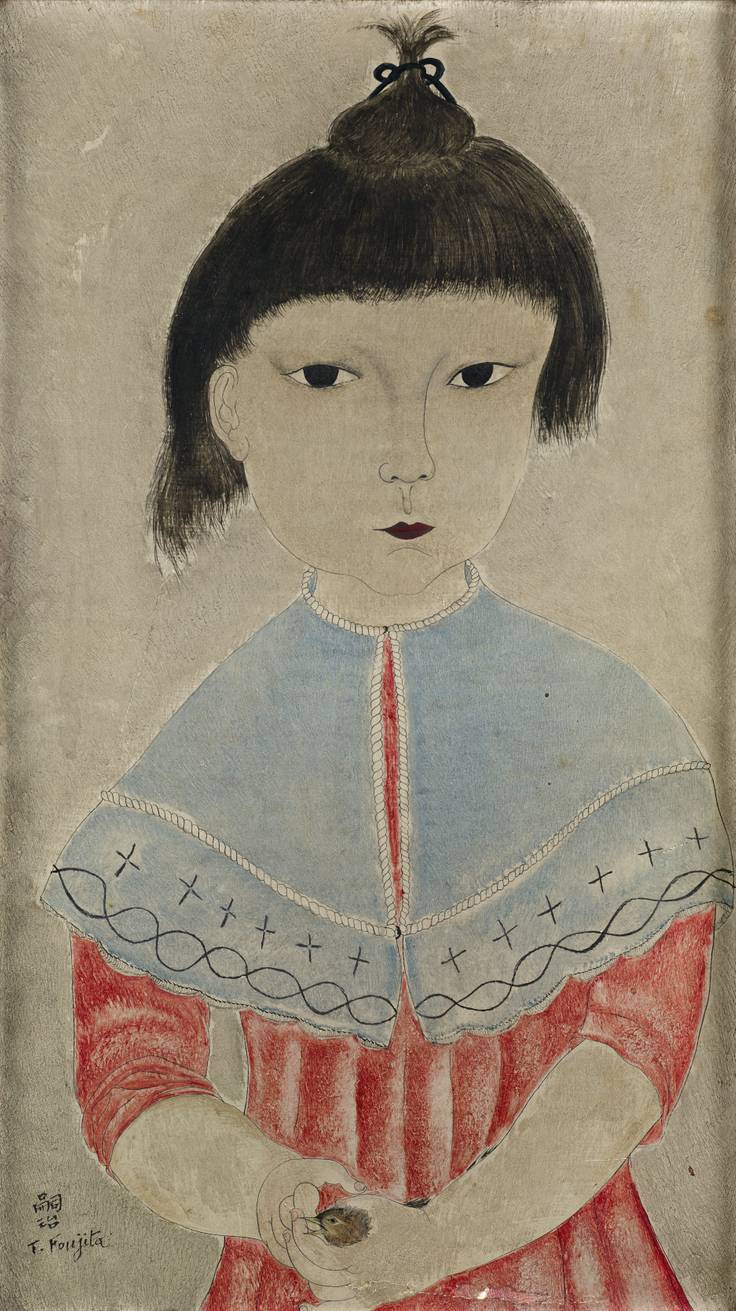Tsuguharu Foujita (1886-1968) Fillette à l’oiseau (Little girl with bird)
Lot 509
200 000250 000
Signed 'T Foujita' and inscribed in Japanese (lower left), signed again and dated '1921' on a stretcher on a reverse and inscribed Paris in Japanese
Oil on canvas
32.5x18.5 cm
executed in 1921
Provenance: collection Lord Yehudi Menuhin (1916-1999), Switzerland
Private collection, Europe
In hybrid work that brings traditional Japanese techniques and perspectives together with the ideas of the European avant-garde, Léonard Tsuguharu Foujita became one of the most esteemed artists in Paris during the 1920s.
After completing his studies at the Tokyo National University of Fine Arts, Foujita moved to Paris where he met and befriended many of the leading artists of the time.
Having signed up with the respected art dealer Georges Chéron, who also represented Foujita’s friend Amadeo Modigliani, Foujita had his first solo exhibition in 1917. For this exhibition at Gallery Chéron, he showed 110 watercolours which sold out on the first day, with Pablo Picasso buying a number of the works. A few years later, the inclusion of his painting of Kiki de Montparnasse, Nu couché à la toile de jouy (Reclining nude with toile de jouy) in 1922’s Salone d’Automne was a big success, further cementing his reputation as a leading artist of the time.
Born in Tokyo in 1886 to a well-off family, Foujita was the son of a general in the Japanese imperial army. Known to his friends as “Fou Fou”, Foujita was an extravagant figure who loved to socialize, and was known for his distinctive bowl haircut, round glasses, large gold earrings, and eccentricities such as donning a lampshade as a hat.
Over his lifetime he married five times, living in France, Japan (where he returned to during WW2), South America and the USA before settling back in France where he gained citizenship in 1955. There he was awarded the Legion of Honour in 1957, and converted to Catholicism in 1959 when he was baptized with the name Léonard.
To commemorate the 50th anniversary of his passing, in 2018 retrospectives for Foujita’s were held in Japan and France, including at the Tokyo Metropolitan Art Museum, the Musée Maillol in Paris.
Fillette à l’oiseau is included in the fourth volume of Foujita’s catalogue raisonné, written by Sylvie Buisson. It is in many ways a classic example of the artist’s painterly approach, from the decade that brought him the highest acclaim.
Often known for his paintings of cats and female nudes, Foujita was also celebrated for his portraits and self-portraits, and over the years painted a number of children’s portraits. In his paintings Foujita often used both oil and touches of the black Japanese ink called sumi, and preferred the ultra-precise Japanese menso brush. Indeed, known more for the quality of his lines, colour typically plays a secondary role in Foujita’s paintings, where he skilfully utilizes a limited colour palette to great effect. This can be seen in Fillette à l’oiseau, for instance in the detailed, fine lines of the girl’s hair, and in how Foujita limits himself to blacks, blues and red.
Foujita’s skills as a draughtsman can also be seen in the drapery of the girl’s red dress, and the details and trim on the blue cape. The young girl’s large, dark, almond shaped eyes are a striking feature, and the silver-grey sheen that immerses this portrait creates a dreamy atmosphere, strengthening the power of her hypnotic gaze.
Collection Lord Yehudi
Menuhin (1916-1999) Lord Menuhin of Stoke
d’Abernon was an American-born violinist and conductor. A child prodigy, he started playing at the age of four and he is considered one of the great violinists of the 20th century. He played the Soil Stradivarius, considered one of the finest violins made by universally famous Italian luthier Antonio Stradivari.
Throughout his life, he tirelessly took up the cause of the oppressed. Worth mentioning are his denounce of the injustice of Apartheid in South Africa, where he gave free concerts for the black community, his tour in Israel playing in Palestinian refugee camps and his performances for Allied soldiers during World War II and for the surviving inmates of a number of concentration camps in July 1945 after their liberation.



